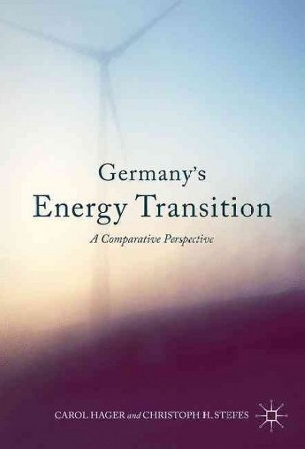
Germany’s Energy Transition: A Comparative Perspective by Carol Hager and Christoph H. Stefes

This collection of essays sets out to explain the origins and realization of the German “Energiewende” – the groundbreaking phase out of nuclear power and phase in of renewables that the country has witnessed over the past decades. It is one of the first works to offer a comprehensive analysis of the German energy transition for an English speaking audience. Given the growing urgency to address climate change, understanding the dynamics of energy transitions is all the more essential, and in this the book is a wonderful contribution to existing knowledge of the topic. It self-purportedly has as its audience students of German politics and energy policy more broadly, but is of interest to anyone seeking to gain further insights into processes of political change, given the focus of the book on the ways that political institutions change, or resist change.
The book offers a Neo-Institutionalist account of energy transitions. It tells a story of institutional norms, critical junctures, policy equilibrium and path dependency. In its plotting of institutional dynamics the book demonstrates what is possible, and the huge potential for us to decarbonize society. In these challenging times, this is a handbook for energy revolution, which both scholars and policy makers alike would do well to read. Using the German case as its starting point, the books follows the Energiewende from grassroots activism, to participation of subnational actors, to key critical junctures, and then places it in a European context. Further insight is gained through comparative analysis with US, China and Japan.
The book develops the argument of critical modernization theory within a number of chapters. The theory posits that pressure for institutional change arises not from the imperatives of modern industrial democracy, but from critical voices in society. These voices are therefore often direct sources of ecological innovation rather than the traditional policy players. This approach brings previously overlooked phenomena into focus. For instance, the first chapter on “The Grassroots Origins of the German Energy Transition” by Carol Hager, develops a fascinating account of how Not In My Back Yard (NIMBY) grassroots protest politics was linked to technological innovation. Those activists who fought against nuclear power site at Wyhl began to not only criticize the old but develop new: in forms of knowledge to challenge; realizing alternatives; setting up renewables energy businesses. This directly lit the spark for key technological advances which were to crystalize the Energiewende.
This attention to the role of grassroots activism fills a key gap in the existing literature, leading to a greater appreciation of the broader implication of protest that previously was only assessed in relation to the specific and immediate controversy. This has implications for policy, in holding space to listen to critical voices in society and for those activists it maps how to be effective, noting it is essential to ground oppositions in science and offer real plausible alternatives.
This analysis demonstrates how institutional dynamics can be adjusted by savvy policy entrepreneurs and new players. In the previously top-down nature of German energy politics citizens gained access to policy planning by educating themselves, and developing “counter-expert” knowledge. Such work culminated in the 1990 Feed-in Law which grated access to the grid to small energy produces at a guaranteed price. Such tariffs have been essential to the decentralized spread of renewables in Germany.
In the chapter “Critical Junctures and the German Energiewende” Christoph H. Stefes skillfully unpacks the key turning points in the pathway to energy transition. It demonstrates how key actors and policy entrepreneurs interact with the institutional framework, making use of policy windows and opportunities for change which will enhance their position. The chapter highlights how, against the backdrop of institutional drift, the initial losers of the adjustments of the energy mix, such as the traditional energy monopolies, have begun to regain control, putting brakes on the Energiewende and potentially derailing it entirely. In the following chapter “The German Energiewende in a European Context” gains analytical leverage and new appreciation of the German case by way of comparison with its European neighbors. It notes the incredible achievement and power from example that could be gained if Europe and Germany were to achieve transitions. In these times of shifting geo-political power relations, this is where EU strength and leadership could come from. Beyond this the piece offers a great overview of the developments underway both in neighboring countries and further afield. In this manner it sets the context for the comparisons as made within the following chapters in depth case study analysis.
The comparative case study chapters demonstrate how specific cultural context impact on energy revolutions. They also work to underline the nature of institutional norms and dynamics, in diverse cultural contexts. Frank N. Laird begins by plotting the use of institutional layering in the US to promote renewables. He notes how rather than challenging traditional energy providers, existing rules and norms were left in place and the new ones of renewables were simply layered on top of the old. This marks it as different from the German case, which charted new explicit pathways for renewable energy. In this an appreciation for cultural context and institutional nuances is gained. In the case of the US energy security is seen as a “birthright” so the move to renewables, which are at seen as less reliable, had to be contained within a package of broader energy development. In the case of China, Case Stephanie Oshita demonstrates how the push for changes to the energy mix grew out of public concern over air pollution. Again, cultural context is as at the heart of this account as the chapter argues that China’s transition to sustainable energy is shaped by the social contract between the Chinese people and the Communist Party. As such, the government must lead such transitions in order to deliver economic development and social security – and thus maintain political power. The accounts of the diverse cases reveal shared truths about the dynamics of policy direction and perennial nature of institutions. Combined, the comparative cases works to enhance the already in-depth description of the German case as outlined in the books initial chapters.
The final comparative chapter on the case of Japan by Llewelyn Hughes draws further lessons from German case and how they can be applied going forward. It notes how the 11 March 2011 earthquake and subsequent Fukushima disaster sent shockwaves into the German system, which have since reverberated out by way of the Energiewende, now influencing the Japanese case despite nuclear entrenchment. As in other chapters it shows the critical junctures shared by countries and possibilities for growth of Japanese renewables in energy mix despite setbacks. In this it is demonstrated that the limits of national institutions are permeated by the now global norms of renewables and energy transitions, which are diffusing across national boundaries.
Such analysis paints an interesting picture of the different pathways within cases, yet highlights the parallels in how changes come about as shaped by institutions. Its approach leads to a rather exclusively institution centric appreciation of the energy issue, which somewhat overlooks other important dynamics in decarbonizing our societies. Although the book references the need for energy efficiency and reducing overall energy use it could have benefitted from a wider acknowledgement that energy politics is not just the remit of state level politics, but encapsulates the real energy needs of people and societies, which too have to be addressed and reduced in order to achieve sustainability. Indeed the energy transition cannot be assessed in isolation but needs to part of a wider transformation of our entire industrial model. However, the analysis as offered by the book still offers important insights for understanding change, which could be utilized in charting the broader transitions societies need to undertake. Overall this is a skillfully woven together book, well worth a read to all those hoping to gain academic and practical knowledge of the dynamics of energy transitions.
Louise Michelle Fitzgerald, University College Dublin
Germany’s Energy Transition: A Comparative Perspective
by Carol Hager and Christoph H. Stefes (Eds.)
Publisher: Palgrave Macmillian
Hardcover / 235 pages / 2016
To read more book reviews, please click here.
Published on June 6, 2017.




